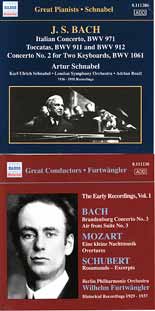

 |
 |
|
 Three from Naxos: Three from Naxos:
Bach, Mozart & Schubert Schnabel (1936-50) & Furtwängler (1929-37) Naxos Historical 8.111286 & 8.111136 In a review listening routine of mainly unfamiliar music, old and contemporary, in new hi-fi recordings, it is always pleasurable anticipation to receive Mark Obert-Thorn's judicious transfers, and these two are no exception. It takes but moments to forget the age of the recordings. Schnabel's no-nonsense approach to Bach (at a time of the burgeoning trend to play Bach on instruments of his time, with Landowska was at its vanguard) is refreshing. His natural tempo relationships, and the intimacy of some pieces (he believed the WTC and even the Suites unsuitable for the concert hall) is well conveyed. He is joined by his son Karl in the double concerto BMV 1061. Furtwängler never ceases to astonish. No eagerness to hear Eine Kleine Nachtmusik yet again, but as Colin Anderson tells us in his study of Gustav Heinrich Ernst Martin Wilhelm Furtwängler in Berlin during the 1930s, he brings significance to every bar, "there is much for the listener to concentrate on". The Bach Brandenburg 3 is of its (Furtwangler's) time and reminded me of Henry Wood doing it at the Albert Hall with a full symphony orchestra's strings. Good to hear once in a while, as are Stokowski's unashamed orchestrations of Bach. Finzi Dies Natalis etc Naxos 8.570417 I used to love Finzi's Dies natalis in my younger days, but now I find his leisurely style too 'samey', despite James Gilchrist's dedication to his task, so I shall pass it on to a colleague more in sympathy with English pastoralism... and one from NMC:
Far more invigorating is a splendid compilation for NMC of original compositions and arrangements for pianola, "one of the most widely misunderstood musical instruments in the world", explains Rex Lawson Strongly recommended for entertainment and illumination. Grieg & Tchaikovsky (piano rolls) Grainger, Horowitz etc Dal Segno DSPRCD 035 This is almost as interesting a CD as Rex Lawson's reviewed above, but the presentation is disappointing, with redundant biographical notes on Tchaikovsky and nothing about the 1992 recordings from Denis Condon's collection of piano rolls, or the editions used of the (mainly) orchestral transcriptions for piano. As I understand it these recordings were made with a ‘push up’ device that can transcribe and ‘play’ the Piano Rolls onto any modern day piano. What we are not told is to what extent there is human intervention (c.p, Rex Lawson and his pianolas). Percy Grainger has the lion's share, with Grieg's Peer Gynt and Norwegian Folks songs plus the Nutcracker Suite Op. 71a, and he displays great sensitivity and subtle dynamic control. The young Horowitz is virtuosic in the central section of Tchaikovsy's Dumka. And it is amazing how sensitive is Gabrilowitsch in Tchaikowsky's October from 1911. I wonder if anyone has thought to try to get even closer to the original performing experience by recording some of these rolls onto pianos of a simiar time, instead of (as here) a "new concert-grand piano" (unspecified)? See http://www.pianola.org/reproducing/reproducing.cfm Peter Grahame Woolf Comment: Rex Lawson responds to advise us that for use of a piano of a similar time the de Falla Montanesa track (c. 1912) to be heard on line is reproduced on a Steinway 'O' of the period, which is about the size they used for recording. He finds it remarkable that such intimacy can have survived since 1912, when it was recorded. [Editor]
|